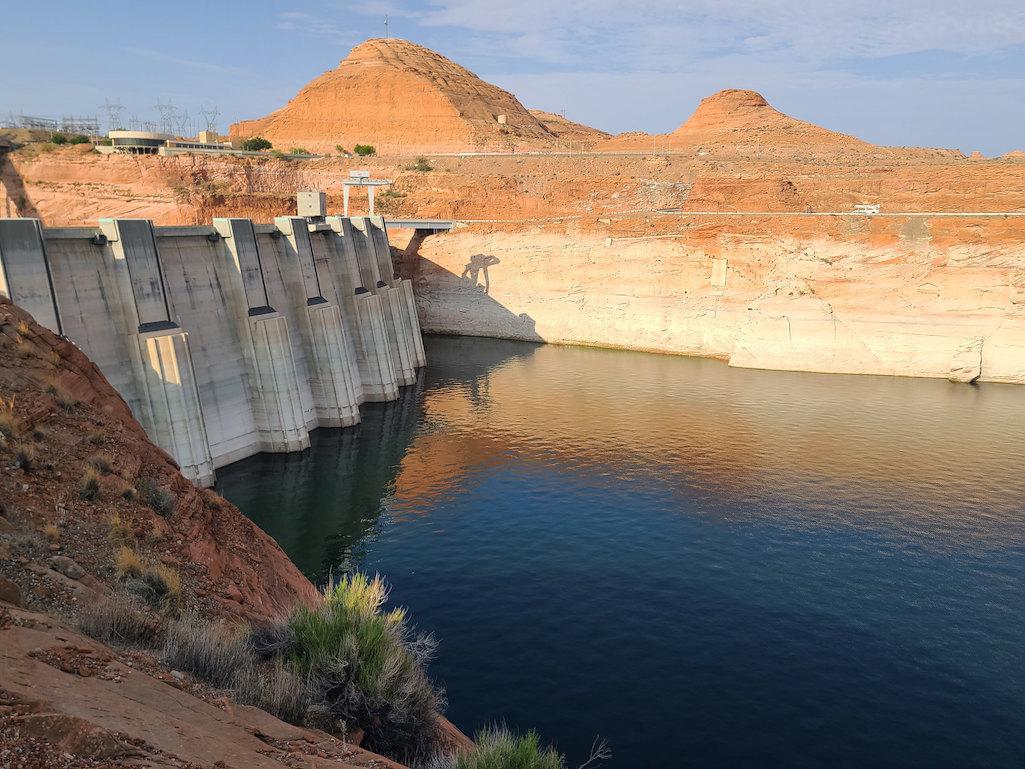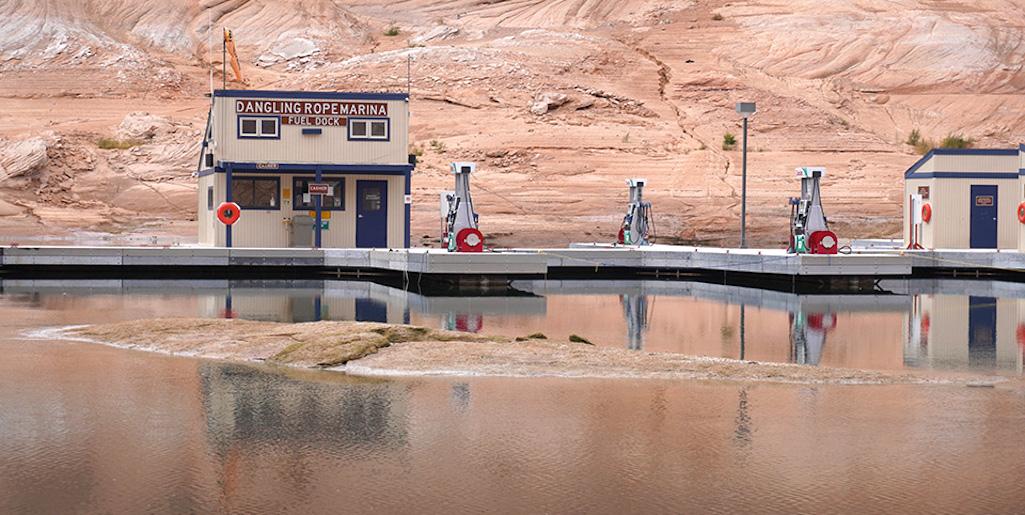
Dropping levels at Lake Powell are forcing a reduction in outflows from the Glen Canyon Dam/BuRec photo from August 2021. The white on the sandstone reflects where the water level once was.
Continued declines in runoff into the Colorado River are forcing federal officials to alter releases from Glen Canyon Dam and leading to a year-long closure of the Dangling Rope Marina at Lake Powell in Glen Canyon National Recreation Area.
In a bid to keep the hydroelectric generating plant in the dam operational, the U.S. Bureau of Reclamation has adjusted the monthly releases from Lake Powell to hold back 350,000 acre-feet of water each month from January to April when inflows to the reservoir are low.
The same amount of water will be sent downstream to Lake Mead between June and September after spring runoff, the agency said.
“Under the Drought Response Operations Agreement, making these monthly operational adjustments at Glen Canyon Dam is essential to protect Lake Powell from dropping to critically low elevation levels in the weeks and months ahead,” said BuRec's Upper Colorado Basin Regional director, Wayne Pullan. “Although the basin had substantial snowstorms in December, we don’t know what lies ahead and must do all we can now to protect Lake Powell’s elevation.”
The modified release pattern was put into action after BuRec staff met with basin partners including the basin states, tribes, federal agencies, non-governmental organizations and water managers to discuss the purpose and need to shift the delivery schedule of water.
According to a BuRec release, the 2022 water year got off to a promising start in the Colorado River Basin with a wetter-than-normal October, but it was followed by the second-driest November on record that resulted in a loss of 1.5 million acre-feet of inflow for Lake Powell compared to the previous month’s projections. December projections showed the reservoir dropping below the target elevation of 3,525 feet as early as February 2022, the agency said. As defined in the Drought Response Operations Agreement, the target elevation provides a sufficient buffer to allow for response actions to prevent Lake Powell from dropping below the minimum power pool elevation of 3,490 feet, the lowest elevation that Glen Canyon Dam can generate hydropower.

The Dangling Rope Marina on Lake Powell will not open this year/NPS file
Meanwhile, Glen Canyon NRA officials announced Monday that the Dangling Rope Marina in the southern end of Lake Powell will not open this year.
Due to dropping reservoir levels, park and concessioner staff are removing marina components from the Dangling Rope location to ensure they do not become beached and inaccessible.
The park, in partnership with concessioner Aramark, is continuing to look for a way to provide mid-lake fuel service during the 2022 season. Available options are complicated by lake levels that continue to decline, inherent challenges associated with the infrastructure needed to power and operate a fuel system, and operational considerations related to safety, staffing, and resources. We will continue to provide updates as they become available.
Restoring visitor services at the Dangling Rope Marina remains a high priority for Glen Canyon National Recreation Area. The importance of this visitor use area is identified in the park’s General Management Plan. The park will continue to seek long-term solutions that maintain a mid-lake marina presence at low and high lake levels.
“Dangling Rope is part of the park’s comprehensive drought response efforts. We know Dangling Rope is important to our visitors and is also extremely important to the National Park Service and our operations,” said Glen Canyon Superintendent William Shott.
Dangling Rope Marina has been the only place to obtain boat fuel between the Wahweap area in South Lake Powell and the Bullfrog area in North Lake Powell, a distance of approximately 100 miles. Boaters should plan ahead for their needs. For boaters averaging 20-25 mph, the trip to Bullfrog from Wahweap takes at least four to five hours. Fuel remains available at Wahweap, Antelope Point, and Bullfrog Marinas.



Comments
Yes, consumption is a very large problem. But remember Utah is a GQP state where any common sense or scientifically based requests by anyone attached to the federal gummint is either completely ignored or met with rabid blatherings of Don't Tread on Me. We actually have cities where it's illegal to let your grass turn brown. Conservation of anything is regarded as a liberal conspiracy.
It's a desert, good people, a DESERT! End of story. Rain does not follow the plow (the 19th century's version of the argument) nor do dams allow humans to exceed natural limits (the 20th century's favorite excuse). And stop worrying about who's watering the lawn. Who's flushing the toilet is the point. 150 million toilet flushers will drain any dam. The 21st century's excuse is of course climate change. We can fix this if we try really hard! God screwed up again. Google is working on it! No wonder we're such a mess.